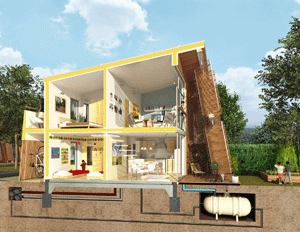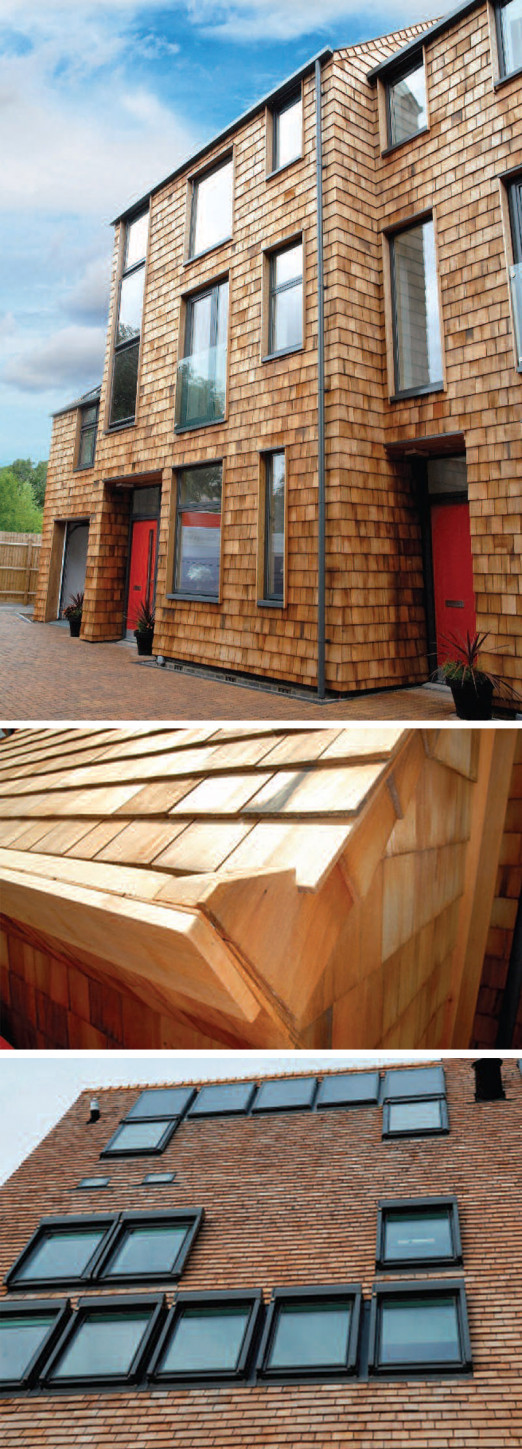Scheme description
Hanham Hall is England's first large-scale housing scheme to achieve the 2016 zero-carbon standard, and is one of the flagship Carbon Challenge schemes promoted by the HCA. Barratt and HCA are working in partnership with South Gloucestershire Council and Sovereign Housing.
The development provides 187 new homes for private and affordable housing. Located in South Gloucestershire, 7km from the centre of Bristol, the nine-hectare site adjoins the green belt, bordered by suburban housing. Landlocked on site the Hall has been refurbished and successfully adapted. Central to the vision of the development it provides an important sense of identity and history, adding vibrancy to the community through uses such as office space, a crèche, and cafe. The layout and style of the design respond to the site's unique characteristics and constraints. Green belt restrictions and the need to retain views of the Hanham Hills meant more than a third of the site could not be built on. All homes achieve the new 'Zero' standard and outperform the building regulations and other widely used industry standards. Initial Building for Life 12 assessment shows 12 green lights.
Hanham Hall is packed with innovative ideas. The design prioritises views and light. Windows openings are oriented to be rotated to achieve maximum daylighting. Living rooms open onto generous balconies and verandahs, shaded by screens. These spaces are an important link between the public and private realm. Overlooking the shared gardens and amenity spaces they create a sense of community and safety.
The usable volume of the home has been maximised to create a greater sense of space and light. The exterior timber shading transforms a house, complying to rigorous building standards, into something more human, the natural wood blending in with the landscape of the countryside. Roads have shared surfaces so pedestrians and cars and bikes can use the same paths, and roads are linked to cycle paths to encourage people to drive less and walk and cycle more. Homes are 10% larger than open market housing and discrete street parking ensures main public spaces remain vehicle free.
The scheme addresses local housing requirements by providing a wide range of accommodation, from 1 bedroom flats and coach houses to five bedroom houses. These are arranged in terraces, semi-detached and detached arrangements to create varied urban form. A significant proportion of the homes are family homes with parking in-curtilage or adjacent to the home. Smaller apartments provide an accessible entry level to the housing market, whilst coach houses provide a good intermediate step between houses and apartments. Hanham Hall will be run by its residents, who will all have a share in a Community Interest Company set up to manage and maintain the buildings and grounds. It will promote community initiatives such as car-sharing clubs, gardening groups and walking school bus projects. The company will empower residents to shape their community and to create the resources they need for a sustainable future.
Whilst Hanham Hall has been tailored closely to its environment, this underlying design approach for Placemaking can be replicated anywhere. The key ingredients are a holistic approach to design and an understanding that people want to be empowered rather than coerced to live sustainably. Beautifully landscaped, open, friendly: Hanham Hall looks like a place where people aspire to live.
Description of any private and/or public outdoor space or other amenity There are 3.7 ha of meadows, orchard and allotments adjacent to development. These green areas now provide shared amenity spaces. A new park leads through to greenhouses, an apiary, allotments to grow vegetables in, orchards, children's play spaces, a village green, formal gardens, a swale and pond and meadow grass beyond, and private gardens or balconies to all homes.
Brief planning history
The Hall itself is a Grade II* listed building from the mid-17th century. Originally a family home surrounded by extensive gardens and open land, it became a psychiatric hospital in around 1900, which closed in 2000. The Hanham Hall site has a complicated planning history dating back to its former use as a hospital. Many of the buildings on the site for hospital use were never subject to planning and development control, and consequently invasive changes were made to the interior and exterior of the Hall with further buildings distributed insensitively across the site with little regard to the remaining historical structures or impact on the landscape. Attempts to redevelop the Hall and surrounding site for residential purposes were made from the mid 1990s until it was included as part of the Carbon Challenge competition in 2007, with Barratt Bristol selected as the preferred development partner in December of that year. The application for the site was submitted in December 2008 and approval was gained in November 2009.
Community Consultation
The biggest challenge at Hanham Hall was to design a scheme that would meet stringent building standard requirements and satisfy all stakeholders. To achieve this balance we created a structured engagement programme working with a vast range of parties including our client and design team partners, the Homes and Communities Agency, English Heritage, South Gloucestershire Council as he Local Planning Authority, Sovereign Housing Association, the Green Belt Society, local residents, and the supply chain. As the design progressed, the team organised regular briefing meetings with the parish council and held two public consultation events for the wider community. Local people were broadly supportive of the scheme and came along with plenty of questions which were answered thoroughly.
Architects: HTA Design LLP
Client: Barratt Homes
Start Date: 2008
Completion Date: 2013





